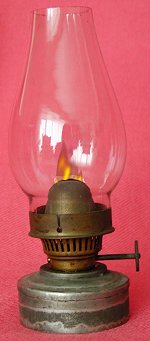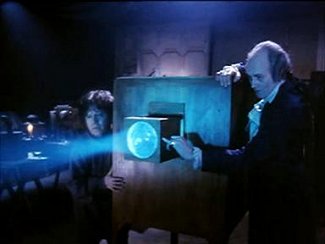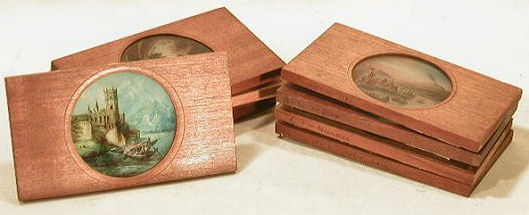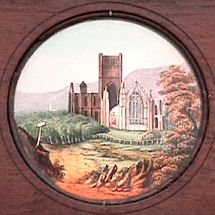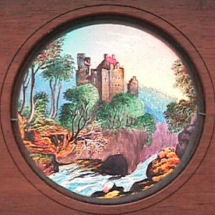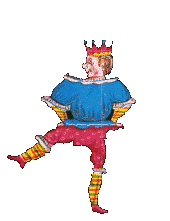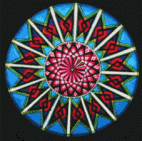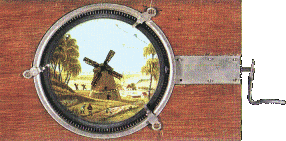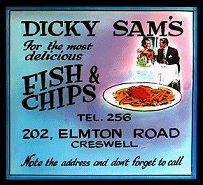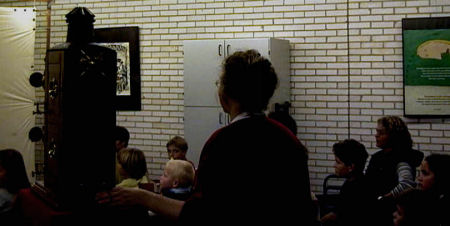 |
Now as with many other inventions,
for instance the art of printing, it is not known exactly who invented
the magic lantern. The 'Laterna Magica' had already been described in an old writing
by a German Jesuit priest and scientist, Athanasius Kircher.
The 1646 edition of his 'Ars magna lucis et umbrae (The great art of light
and shadow) included the description of a primitive projection system
whereby sunlight reflected off a mirror is projected through a lens on a
screen. The second edition, published in 1671, included the first drawings of a magic lantern.
There is a persistent anecdote about this erudite priest. It has to be
considered highly unlikely but it's a beautiful story after all: The father
had thought of a practical application for his invention. While visiting his unfaithful
believers in the evening, he hid a simple magic lantern under
his cowl. When talking did not help anymore, he switched to other,
tougher measures. On the glass of his lantern he had painted a realistic
image of the death, which he projected from the outside on the parchment
windows of the simple farmhouses. That was really successful and had a marked effect.
The next Sunday morning his church was packed to the very
roof again.
|
Athanasius Kircher was certainly not the first to design a magic lantern.
By the time he published his first illustrations, the magic lantern had
already been described by others, like
the Dutch scientist Christiaan Huygens, and was probably in fairly wide
use. In Huygens' books we find the first
description of a complete, working magic lantern and in 1659 already he
constructed a projecting lantern with a three-element lens. For that
reason Christiaan Huygens is today considered the most likely inventor of
the magic lantern.
However Christiaan was not very proud of his
invention. He was ashamed because it appeared that various swindlers were
using his instrument to frighten people. His father, who served at the
French court of Louis XIV, once ordered a lantern upon the king’s
request. Christiaan did not comply with this request because he was afraid
that he would ridicule the Huygens family. (Also read: Christiaan
Huygens, the true inventor).
|
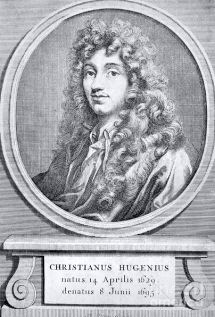 |
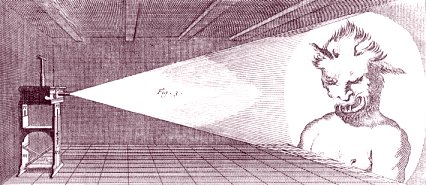 |
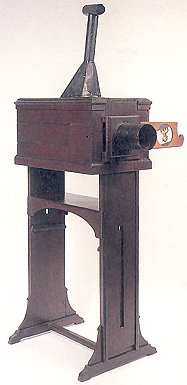 |
|
More Dutch scientists have paid an important role in the development of the magic lantern. The Professor
Willem Jacob van ‘s Gravesande, living in the Dutch town of Leiden, and the
instrument-maker Jan van Musschenbroek improved the equipment quite a
bit. (Also read: The oldest magic lantern in the
world.) At that time four-wick oil lamps came into use, whilst before mostly
a candle had been used as source of light. Van 's Gravesande's
lantern and slides survive in the Boerhaave Museum, Leiden.
|
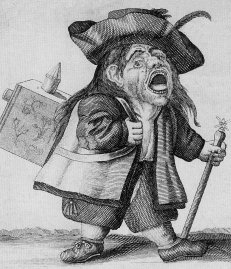 Until the second half of the eighteenth century magic lanterns were mostly used
by scientists, but soon various people realised that it was good
business and took advantage of it. The Dutch word 'Luikerwalen'
(foreigners will probably need a long time to pronounce this word
correctly!) stands for people originating from Luik in Wallonia. They were
travelling all over the country to give performances at fairs,
in pubs etc. The government had forbidden them to carry rat-poison
throughout the country while catching rats had been the main activity of these
people to make a living before, so they had to find a new source of
income. The projector and the accompanying slides they carried on their
backs, were built by themselves in most cases.
Until the second half of the eighteenth century magic lanterns were mostly used
by scientists, but soon various people realised that it was good
business and took advantage of it. The Dutch word 'Luikerwalen'
(foreigners will probably need a long time to pronounce this word
correctly!) stands for people originating from Luik in Wallonia. They were
travelling all over the country to give performances at fairs,
in pubs etc. The government had forbidden them to carry rat-poison
throughout the country while catching rats had been the main activity of these
people to make a living before, so they had to find a new source of
income. The projector and the accompanying slides they carried on their
backs, were built by themselves in most cases.
It is not likely that the misshapen person on the anonymous print from 1720 at the
left is representative of the appearance of the luikerwalen. At that
time lanternists and also hawkers on the whole were mostly portrayed as caricatures. |
|
A real rage in presenting lantern-lectures started. New, much stronger
sources of light than formerly available, made it possible to project big,
bright images for a large audience and it was also possible to project from a distance behind.
The application of limelight meant an enormous
improvement of the performance. The intense white light was produced by
heating a piece of lime, generally with a flame of combined oxygen and
hydrogen gases. Unfortunately many disasters happened due to its use. |
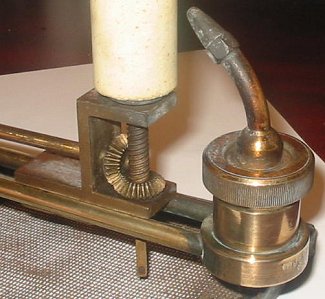 |
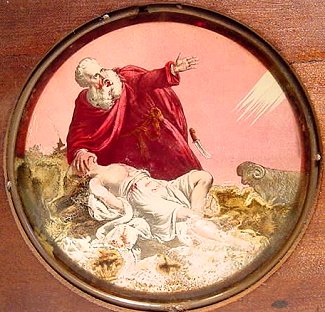 |
Besides its function in the
entertainment-world the magic lantern was used 'for teaching purposes' in
the first place. In doing so, things sometimes got seriously out of hand. In the
'Nederlandsch Magazine', No, 1 of 1863 we can read that the explorer and
missionary David Livingstone showed the local people slides of 'the wonders of creation',
but on occasion also drove the terrified African Balonda tribe
into the bush, when he presented a lantern-picture showing a life-sized
Abraham who was preparing to kill his son Isaac with a knife which he held in
his hand.
(See also: The Bible) |
|
At the end of the nineteenth century
magic lanterns with accompanying lanternslides could be found in all shops
selling scientific instruments. One of the most important outlets in the
Netherlands was Merkelbach & Co. in Amsterdam, later on a well-known
toy shop in the Kalverstraat. The family still owns a letter from the
Royal House, showing that even the little Wilhelmina (later to become
Queen Wilhelmina of the Netherlands) often played with her magic lantern
and with great pleasure. Mr. Merkelbach was urgently requested in this
letter to visit the palace and to bring a great number of
lantern-pictures with him, in order to exchange these for those which were
not of interest anymore. Of course there were no talks about a reasonable
financial compensation at all. It had to be for the honour alone. (Read
all about it in: Some humorous lantern
slides for the little Princess.) |
 |
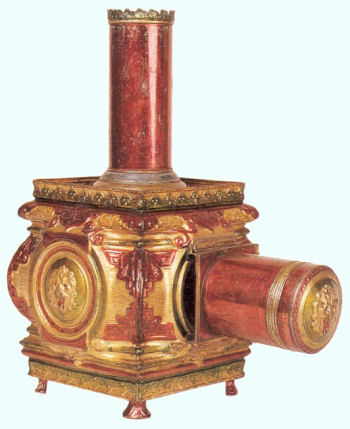 |
The magic lantern gradually found its way
into the living room. The types that were sold for this
purpose were much smaller than their serious brothers.
For the lighting in general a simple small oil-lamp or a candle was used.
A small funnel on top of the lantern regulated a smooth draught and the
removal of combustion gasses. The 'lampascope' was also popular, a magic
lantern with a round hole at the bottom, which could be placed over an
ordinary table-oil-lamp. Such a lamp was already available in most of the
households and by doing so an additional source of lighting was
unnecessary. To prevent the lantern tumbling forward, due to the
weight of the lens, the lid in the back part was filled with sand to make
it heavier. The appearances of the magic lanterns were quite different.
The simplest ones were made of tin plate and did not cost more than one
Dutch guilder. For people who could afford more expensive specimens
were also available; those were made of fine mahogany or were supplied with
inlaid tiles. |
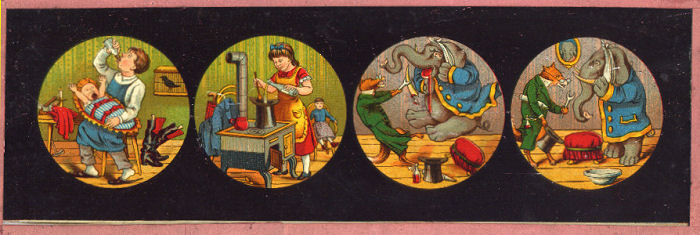 |
|
The lanterns were sold
with matching glass-slides. Four or five round images
were usually printed on the glass-strips.
These often related to fairy-tale figures or subjects taken from real life. The
slides were usually sold in boxes of twelve pieces and did not cost more
than a few Dutch guilders. However they could also cost a few hundred. The
cheapest slides were covered with a sort of transfer (decalcomanias); the most expensive
ones were hand painted and placed in a wooden frame. There were real works of art
among them. |
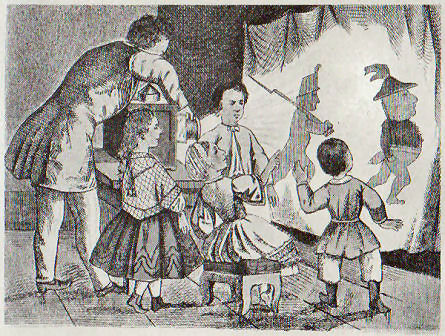




 Until the second half of the eighteenth century magic lanterns were mostly used
by scientists, but soon various people realised that it was good
business and took advantage of it. The Dutch word 'Luikerwalen'
(foreigners will probably need a long time to pronounce this word
correctly!) stands for people originating from Luik in Wallonia. They were
travelling all over the country to give performances at fairs,
in pubs etc. The government had forbidden them to carry rat-poison
throughout the country while catching rats had been the main activity of these
people to make a living before, so they had to find a new source of
income. The projector and the accompanying slides they carried on their
backs, were built by themselves in most cases.
Until the second half of the eighteenth century magic lanterns were mostly used
by scientists, but soon various people realised that it was good
business and took advantage of it. The Dutch word 'Luikerwalen'
(foreigners will probably need a long time to pronounce this word
correctly!) stands for people originating from Luik in Wallonia. They were
travelling all over the country to give performances at fairs,
in pubs etc. The government had forbidden them to carry rat-poison
throughout the country while catching rats had been the main activity of these
people to make a living before, so they had to find a new source of
income. The projector and the accompanying slides they carried on their
backs, were built by themselves in most cases.